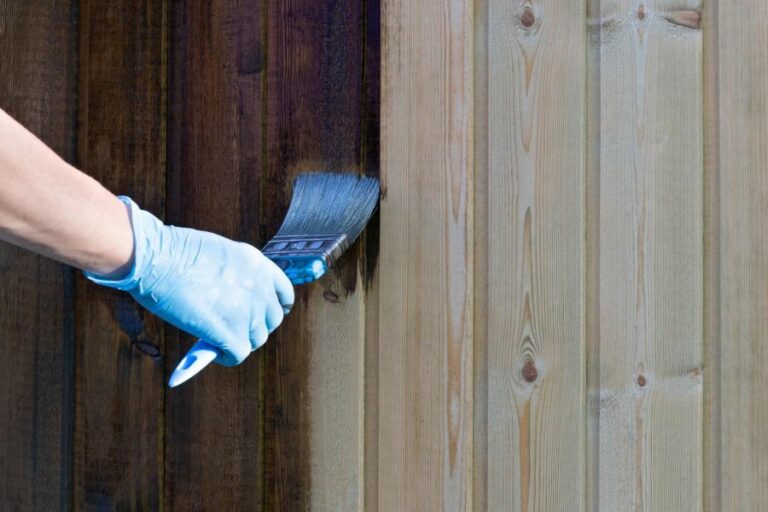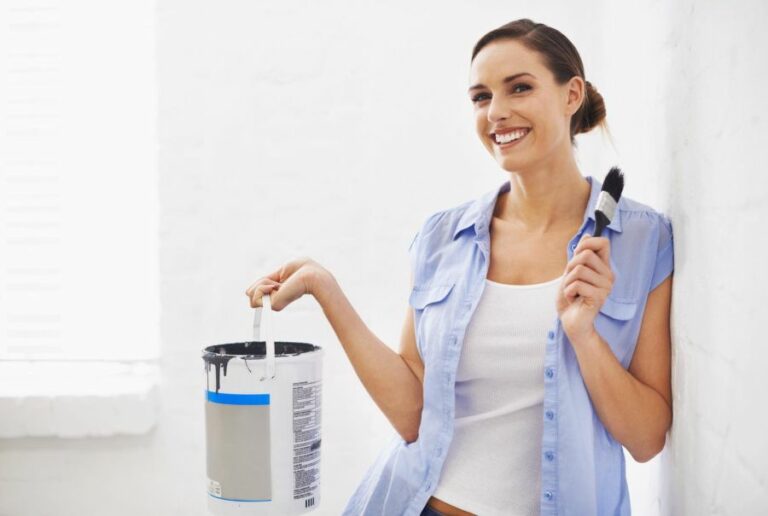Paint For Metal Railings Outdoor, 25 Things You Should Know
Are your outdoor metal railings looking dull and rusty? Breathe new life into them with the comprehensive guide on the best paints for metal railings outdoors! Let’s explore the ideal paint types to withstand harsh weather conditions, prevent corrosion, and enhance curb appeal. Plus, I’ll share expert tips for application and maintenance, ensuring a long-lasting stunning finish.
Paint for metal railings outdoors:
I will outline the importance of choosing the right paint for outdoor metal railings and discuss enamel, epoxy, and acrylic paints. Each type has its pros and cons for durability, weather resistance, and environmental impact. I will also provide information on proper surface preparation, application methods, and maintenance for long-lasting and visually pleasing results.

Discover the perfect paint for your outdoor metal railings with my expert guide. Learn about the best paint types, techniques for longevity and durability, and how to avoid common mistakes. Transform your exterior space for years to come.
Contents
- 1 Exterior Metal Railing Paint for Outdoor Use
- 2 What Type of Paint Should You Utilize for Exterior Metal Railings?
- 3 What is the Optimal Paint Choice for Metal Railings?
- 4 What is the Proper Technique for Painting Exterior Metal Railings?
- 5 Which Paint Sheen is Suitable for Metal Railings?
Exterior Metal Railing Paint for Outdoor Use
When it comes to protecting and beautifying metal railings outdoors, choosing the right paint is crucial to ensure long-lasting and visually pleasing results.
• Selecting the Right Paint: Enamel, Epoxy, or Acrylic?
Three major types of paint suitable for outdoor metal railings are enamel, epoxy, and acrylic. Each comes with its own benefits and drawbacks, depending on the specific requirements of your project.
– Enamel Paint
Enamel paint is a solvent-based coating that forms a tough, glossy, and long-lasting finish. It is known for its excellent adhesion and moisture and weather-related damage resistance.
This makes it an ideal choice for outdoor railings that need to withstand harsh elements, such as those near the coastline or exposed to severe temperature fluctuations.
Pros
- Durable and weather-resistant
- High-gloss finish provides a clean, polished look
- Resistant to chipping, peeling, and fading
Cons
- Longer drying time compared to other paints
- Can be difficult to clean up without special solvents
- May not be as environmentally friendly as other options
– Epoxy Paint
Epoxy paint is a heavy-duty paint designed to provide a strong bond to metal surfaces, making it highly resistant to chipping, peeling, and corrosion. It is a two-component system consisting of a base and a hardener, which must be mixed just before application.
Due to its highly durable and chemical-resistant properties, epoxy paint is a popular choice for industrial settings and high-traffic areas.
Pros
- Very strong adhesion to metal surfaces
- Resistant to chipping, peeling, and corrosion
- Excellent chemical resistance
Cons
- Can be complicated to mix and apply
- Longer drying time compared to acrylic paint
- Costlier than enamel and acrylic alternatives
– Acrylic Paint
Acrylic paint is a water-based paint that dries quickly and is generally easier to clean up compared to enamel and epoxy paints. While it may not offer the same level of durability as the other options, it is still a suitable choice for residential applications where high levels of traffic and wear are not expected.
Pros
- Water-based, making it easier to clean up
- Quick-drying compared to other options
- Lower VOCs (volatile organic compounds), making it more environmentally friendly
Cons
- May not be as durable as enamel or epoxy paints
- Can be less resistant to moisture and weather-related damage
- Gloss and color retention may not be as long-lasting
• Proper Surface Preparation and Application Techniques
Proper surface preparation and application techniques are essential to ensure a long-lasting finish. Follow these steps to achieve the best results:
– Step 1: Clean the Surface
Remove all dirt, dust, and debris from the railing surface using a wire brush, followed by a degreasing cleaner. This will ensure that the paint adheres properly to the metal.
– Step 2: Sand and Prime
Sand the railing surface with medium-grit sandpaper to create a smooth finish and promote proper paint adhesion. If the railing is already painted and in good condition, lightly sand the surface to remove any gloss.
Apply a metal primer as per the manufacturer’s directions, ensuring an even coat. Allow the primer to dry completely before proceeding.
– Step 3: Apply the Paint
Using a brush or sprayer, apply the first coat of paint in thin, even strokes. Allow the first coat to dry according to the manufacturer’s recommendations, and then apply a second coat for added durability and coverage.
Ensure that you do not rush between coats, as this can lead to bubbles, streaks, or an uneven finish.
• Painting Tips and Tricks
Here are some additional tips to achieve a professional-looking result when painting your outdoor metal railings:
- Avoid painting in extreme temperatures, high humidity, or direct sunlight, as this can negatively impact the paint application and drying process.
- Stir the paint well before using, and ensure that it has not expired or separated.
- Use a high-quality brush or sprayer designed for the specific type of paint you are using.
- Keep a wet edge while painting to avoid lap marks and create a smooth finish.
- Give the paint ample time to dry before touching or applying any weight or pressure to the railings.
• Maintenance and Longevity
To maintain the beauty and longevity of your freshly painted metal railings, regularly inspect them for signs of chipping or corrosion. Address these issues promptly with touch-up paint to prevent further damage. Regular cleaning with mild soap and water will also help to preserve your railings’ appearance.
By following this comprehensive guide, you can confidently select and apply the appropriate paint for your outdoor metal railings. With proper preparation, application, and maintenance, you can enjoy a beautiful and long-lasting finish for years to come.
What Type of Paint Should You Utilize for Exterior Metal Railings?
Exterior metal railings serve both a functional and decorative purpose, providing safety and support while enhancing the overall look of your property. Proper maintenance, including the application of suitable paint, is crucial to protect them from harsh elements and extend their lifespan.
• Epoxy Paints: Durable Protection for Metal Railings
Epoxy is one of the most popular and recommended types of paint for exterior metal railings. Epoxy-based paints are known for their excellent durability, chemical resistance, and outstanding adhesion to various surfaces.
Additionally, epoxy resins offer high UV protection, preventing your railings from fading or chalking due to prolonged sun exposure.
Different types of epoxy paints are available in the market, with varying degrees of weather resistance and ease of application. Generally, two-component epoxy paints are preferred for their superior performance, but they may be more challenging to apply due to the need for precise mixing.
In summary, epoxy paints are an excellent choice for your exterior metal railings, providing long-lasting protection against the elements and regular wear and tear.
• Urethane Paints: Another Great Option for Metal Railings
Urethane-based paints are another suitable option for exterior metal railings. Like epoxy, urethane paints provide exceptional durability, chemical resistance, and overall protection for your railings. Additionally, they offer excellent gloss retention, keeping your railings looking vibrant for an extended period.
Urethane paints are available in both one-component and two-component formulations. While the former is easier to apply, the latter often provides superior weather resistance and durability performance.
It is worth noting that some urethane paint products may require a primer coat, particularly on heavily corroded or previously painted railings.
In conclusion, urethane paints are a viable alternative to epoxy paints, offering similar levels of protection and durability for your exterior metal railings.
• Factors to Consider When Choosing Paint for Metal Railings
Before you go about selecting paint for your exterior metal railings, it is essential to consider several factors that can influence your choice.
1. Surface Preparation
Proper surface preparation is crucial for the paint to adhere correctly and provide long-lasting protection. Depending on the condition of your railings, you may need to clean, de-rust, and prime the surface before applying your chosen paint.
Ensure that the paint you select is compatible with your railings’ necessary surface preparation steps.
2. Ease of Application
As mentioned earlier, some paint types, like two-component epoxy or urethane, may require additional steps, such as precise mixing, making them more challenging to apply for amateurs. Consider your skill level and comfort in handling such paints before making your decision.
3. Drying and Curing Time
The drying and curing times of the paint can affect your project timeline and determine how quickly your railings can be put back to use. Epoxy and urethane paints generally take longer to dry and cure than other types of paint.
If you require a quicker turnaround, consider a paint with a faster drying time, such as acrylic or alkyd-based products.
4. Budget
Your budget plays a significant role in determining the type of paint you choose for your railings. Premium epoxy and urethane paints can be more expensive than other options, but their superior protection and durability often justify the investment.
Make sure to weigh your budget against your desired performance level before deciding.
5. Local Environmental Regulations
Lastly, ensure that the paint you select complies with local environmental regulations regarding volatile organic compounds (VOCs), as some products may be restricted in your area.
• Conclusion
To wrap up, keeping your exterior metal railings well-maintained and protected is crucial to ensure they maintain their aesthetic appeal and functionality. Epoxy and urethane-based paints are both excellent choices for these purposes and offer impressive durability, chemical resistance, and weather protection.
When selecting the right paint for your metal railings, consider factors such as surface preparation, ease of application, drying time, budget, and compliance with local environmental regulations.
Regardless of the paint type you choose, proper surface preparation and application techniques are essential to achieving the desired results.
By considering these factors and following this guide, you can give your exterior metal railings a fresh and professionally finished look that will last for years to come.
What is the Optimal Paint Choice for Metal Railings?
When it comes to selecting the best paint for metal rails, a variety of factors, such as durability, adhesion, and the painting environment, must be considered.
• Types of Paint for Metal Rails
Three main types of paint commonly used for metal rails are epoxy, polyurethane, and enamel paints. Each type has its unique characteristics and benefits, and understanding the differences will help you make an informed decision.
– Epoxy Paints
Epoxy paints are widely used in industrial and commercial applications due to their exceptional adhesion, durability, and resistance to chemicals and corrosion. These paints are typically available in two components: a base resin and a hardener, which must be mixed before application.
While epoxy paints offer reliable, long-lasting protection for metal surfaces, they can be more challenging to apply due to their thick consistency and limited working time once mixed.
– Polyurethane Paints
Polyurethane paints are known for their excellent weather resistance, which makes them popular for outdoor applications such as metal railings. These paints create a hard, glossy finish that is resistant to abrasion, making them suitable for high-traffic areas.
On the other hand, polyurethane paints can be more expensive than other types of paint and often require several coats for adequate coverage.
– Enamel Paints
Enamel paints are versatile and easy to apply, making them popular for DIY projects involving metal rails. These paints are available in various finishes, including gloss, semi-gloss, and satin, allowing for customization depending on the desired aesthetic.
While enamel paints may not offer the same durability and chemical resistance as epoxy or polyurethane paints, they are still suitable for many applications, particularly indoor metal rails.
• Factors to Consider When Choosing Paint for Metal Rails
Before deciding on the type of paint to use, consider the following factors to ensure the best results for your project.
– Environment
Consider the environment where your metal rails are located, as this will impact the type of paint needed.
For instance, outdoor metal rails exposed to harsh weather conditions require paint with excellent weather resistance, like polyurethane. Indoor rails, on the other hand, can typically be painted with enamel paint, which is less expensive and easier to apply.
– Surface Preparation
Proper surface preparation is essential for the successful adhesion of paint to metal rails. Different paints may require different surface preparations, so ensure you understand the requirements for the type of paint you choose.
Common surface preparation steps include cleaning, rust removal, and primer application.
– Application Method
Consider the method of paint application, as some types of paint are better suited to specific methods. For example, epoxy paints can be applied using a brush, roller, or spray gun, while polyurethane paints may require spraying for the best results.
On the other hand, enamel paints can typically be brushed or sprayed on, making them a more accessible option for DIY enthusiasts.
– Drying and Curing Time
Each type of paint varies in drying and curing times, which can impact the timeline of your project. Ensure you allow for adequate drying time between coats and before using the metal rails to avoid damage to the paint.
• How to Paint Metal Rails
Follow these steps to achieve professional-looking results when painting your metal rails:
- Clean the surface: Remove any dirt, grease, or grime from the metal surface using a mild detergent and water mixture. Rinse thoroughly and let the surface dry completely before proceeding.
- Remove rust and old paint: Use a wire brush, sandpaper, or a paint scraper to remove any rust or old paint from the metal surface. This step is critical for proper paint adhesion.
- Apply a primer: Use a metal-specific primer to ensure proper adhesion of the paint. Follow the manufacturer’s instructions regarding the application method and drying time.
- Apply the paint: Choose the appropriate paint for your metal rails and apply it according to the manufacturer’s instructions. Allow each coat to dry completely before applying additional coats if needed.
- Apply a clear coat: Depending on the type of paint used, a clear coat may be necessary to protect and enhance the paint job. Follow the manufacturer’s instructions regarding application and drying time.
In conclusion, choosing the best paint for metal rails depends on factors such as the environment, surface preparation, and application method.
By understanding the different types of paint available, such as epoxy, polyurethane, and enamel, and considering your project’s specific needs and challenges, you can select the perfect paint for your metal rails and achieve a professional, attractive, and long-lasting result.
Paint Type | Pros | Cons |
|---|---|---|
Oil-based paints | Provides a hard and glossy finish, resists rust and moisture | Higher VOC content, longer drying time, requires thinner for cleanup |
Water-based (latex) paints | Easy to clean up, dries quickly, lower VOC content | May not provide as durable and glossy finish as oil-based paints |
Acrylic paints | Quick-drying, good adhesion to metal surfaces, easy to clean up | May require multiple coats for best results |
Epoxy paints | Extremely durable, excellent adhesion, resists rust and corrosion | Higher cost, harder to apply, requires mixing two components |
Enamel paints | Provides a hard, glossy finish, resists rust and moisture | Takes longer to dry than acrylic and latex paints, harder to clean up |
Alkyd paints | Hard, durable finish, resists rust and corrosion | Higher VOC content, longer drying time, requires thinner for cleanup |
What is the Proper Technique for Painting Exterior Metal Railings?
Painting outdoor metal railings enhances their appearance and extends their lifespan by providing a layer of protection against rust and corrosion.
• Prepare the Surface of the Metal Railings
Before applying paint, preparing the surface to ensure a smooth and lasting finish is crucial. Take your time with surface preparation, as it plays a significant role in the final result of the paint job.
– Remove Rust and Old Paint
- Inspect the Railing: Examine the railing to identify areas with rust, loose or chipping paint, or any other surface irregularities.
- Remove Rust: Use a wire brush or steel wool to scrub away rust from the metal surface. If sandpaper is more convenient, opt for medium-grit (80-120 grit) sandpaper. For stubborn rust, consider using a rust converter, which chemically transforms rust into a stable, paintable surface.
- Remove Old Paint: Loose or chipping paint should be entirely removed for the new paint to adhere properly. Use a paint scraper or wire brush to scrape off the loose paint. Alternatively, employ a chemical paint stripper for thicker paint layers.
– Clean and Degrease the Metal Surface
It’s essential to clean the metal surface to remove dirt, grease, and any residual dust from the rust and paint removal process.
- Wash the Railings: Mix a solution of water and mild detergent, and use a sponge or cloth to clean the railing thoroughly. Rinse well with clean water to remove any soap residue.
- Degrease the Railings: Apply a metal degreaser according to the manufacturer’s instructions. This step is vital in ensuring the paint adheres properly and results in a long-lasting finish.
- Allow the Surface to Dry: Before proceeding to the next step, make sure the railing is completely dry. Use clean, dry rags to wipe the surface, or let it air dry.
• Choose the Right Paint and Primer for Metal Railings
To achieve a durable finish that resists rust, choosing the right paint and primer specifically formulated for use on metal surfaces is vital.
– Use a Metal Primer
Applying a metal primer enhances paint adhesion and provides an additional layer of rust protection. Opt for a rust-inhibiting primer for better results. If the railing is heavily rusted or you are painting over galvanized metal, consider using a galvanized metal primer.
– Select a Durable Paint
Choose a high-quality, weather-resistant paint that is specially formulated for metal surfaces. Using weather-resistant paint ensures the paint job will withstand outdoor elements like sun, rain, and humidity.
Additionally, opt for a paint that dries to a hard finish for better resistance against chipping and scratching.
• Prime and Paint the Metal Railings
To achieve a professional-looking paint job, follow these steps:
– Protect the Surrounding Area
Cover the area below and around the railing with drop cloths or tarps to protect them from paint drips.
– Apply the Metal Primer
- Stir the Primer: Stir the primer well to ensure proper consistency.
- Apply the Primer: Use a brush or a roller to apply an even coat of primer to the railing. Remember to coat all sides and crevices for optimal rust protection.
- Allow the Primer to Dry: Follow the manufacturer’s instructions for the recommended drying time before applying paint.
– Apply the Paint
- Stir the Paint: Stir the paint well to make sure it is thoroughly mixed.
- Apply the Paint: Use a brush or a roller to apply a thin, even coat of paint to the railing. Opt for multiple thin layers rather than a single thick layer for better coverage and a smoother finish.
- Allow the Paint to Dry: Let the paint dry according to the manufacturer’s instructions before applying additional coats.
- Apply Additional Coats: Apply two to three coats of paint for the best results, allowing each layer to dry before applying the next coat.
- Inspect the Railing: Once the final coat has dried, inspect the railing to ensure even coverage and a smooth finish.
• Allow the Paint to Cure
Give the paint sufficient time to fully cure before subjecting the railing to heavy use. Check the paint manufacturer’s instructions for the recommended curing time, typically between four to six hours.
Following these steps will help you achieve a professional-looking, durable finish that enhances the appearance of your outdoor metal railings and offers protection against rust and corrosion.
Step | Description |
|---|---|
1. Clean the railings | Remove dirt, dust, and cobwebs with a brush or cloth. Use soapy water to wash off grease and grime. Allow the railings to dry completely before proceeding. |
2. Remove old paint and rust | Use a wire brush, sandpaper, or a paint scraper to remove any loose, flaking, or peeling paint. Make sure to remove as much rust as possible to ensure proper adhesion of the new paint. |
3. Apply a rust converter (optional) | If there is substantial rust remaining on the railings, apply a rust converter according to the manufacturer’s instructions. This will help prevent future rusting and improve the paint’s durability. |
4. Apply metal primer | Select a primer specifically designed for metal surfaces, which will help the paint adhere better and last longer. Follow the manufacturer’s instructions for application, and let the primer dry completely before moving on to the next step. |
5. Paint the railings | Choose high-quality paint designed for metal surfaces, and apply using a brush, roller, or paint sprayer. Apply multiple thin, even coats, allowing each to dry completely before adding the next. Be sure to cover all surfaces, including any nooks and crannies. |
6. Apply a clear sealer (optional) | If you want to provide additional protection for your newly-painted railings, apply a clear, exterior-grade sealer according to the manufacturer’s instructions. This may help prolong the life of the paint and protect against fading, chipping, and other wear-and-tear. |
7. Clean up | Dispose of any used brushes, rollers, or other materials in accordance with local regulations. Store any leftover paint and supplies properly for future touch-ups or projects. |
Which Paint Sheen is Suitable for Metal Railings?
Painting metal railings is an essential aspect of maintaining their appearance and durability. Choosing the right paint sheen, or glossiness, is crucial to achieving the desired results.
• Understanding Paint Sheen
Before delving into the specifics of metal railings, it is essential to understand what is meant by the term ‘paint sheen.’ Sheen refers to the glossiness of the paint finish, which can affect both its appearance and durability on a surface.
There are five primary paint sheens, ranging from flat (or matte) to high-gloss:
- Flat (Matte)
- Eggshell
- Satin
- Semi-gloss
- High-gloss
Each sheen has its unique characteristics, which are suited to different applications and requirements.
• Flat (Matte) Sheen for Metal Railings
Flat or matte finishes provide a non-reflective surface, absorbing light rather than reflecting it. This sheen is ideal for concealing imperfections on surfaces, as the lack of reflection minimizes the visibility of any flaws.
However, flat paints are not recommended for metal railings. Due to their porous nature, they are more susceptible to moisture and staining, which can lead to rusting and reduced durability of the railing.
Furthermore, flat paints are less resistant to cleaning, meaning they will wear down with regular maintenance more quickly than other sheens.
• Eggshell Sheen for Metal Railings
Eggshell finishes provide a slight sheen, offering a more washable and durable surface than flat paints. They are often used for walls, particularly in bedrooms and living rooms, where a low sheen is desired for its subtle appearance and enhanced durability.
While eggshell paints offer more moisture resistance than flat paints, they are still not ideal for metal railings. The slight sheen is not sufficient to protect against rust, and the durability is not enough for exterior or high-traffic applications.
• Satin Sheen for Metal Railings
Satin finishes strike a balance between appearance and durability. They offer a more attractive sheen than eggshells, reflecting more light and providing a smooth appearance. They are also more durable and easier to clean, making them suitable for higher-traffic areas and some exterior applications.
Satin sheens can be suitable for metal railings, particularly if they are not exposed to the elements or utilized in a high-traffic area, such as an interior railing. However, a more robust sheen, such as semi-gloss or high-gloss, for exterior applications or railings subject to frequent use, may be a better choice.
• Semi-gloss Sheen for Metal Railings
Semi-gloss finishes offer an attractive balance of sheen and durability. They reflect more light than satin finishes, providing a smooth and bright appearance while offering good moisture and staining resistance.
For metal railings, a semi-gloss sheen is a popular choice. The increased reflectivity provides improved protection against rust and corrosion, and the surface is easier to clean and maintain than lower sheens.
Semi-gloss paints are recommended for exterior railings and high-traffic areas, offering a balance of appearance and functionality.
• High-gloss Sheen for Metal Railings
High-gloss finishes provide the highest level of reflectivity, offering excellent protection against moisture and staining. They are the most durable paint sheen, making them ideally suited for high-traffic areas, exterior applications, and surfaces exposed to moisture.
A high-gloss sheen offers the best protection against rust and corrosion for metal railings. The highly reflective surface repels water and keeps moisture from penetrating the underlying metal, ensuring longevity and a beautiful appearance over time.
High-gloss sheens also make cleaning and maintaining railings easier, allowing grime and dirt to be wiped away with minimal effort.
• Expert Recommendation
For most metal railing applications, a high-gloss sheen is an optimal choice. This sheen provides the best protection against rust, corrosion, and wear, ensuring a long-lasting and beautiful railing.
A semi-gloss sheen is the next best option if a high-gloss finish is deemed too shiny for the application. While not as protective as a high-gloss sheen, it still offers good moisture resistance and durability.
In conclusion, when choosing a paint sheen for metal railings, consider factors such as exposure to the elements, traffic levels, and desired appearance.
High-gloss and semi-gloss sheens are the most suitable choices for metal railings, offering a balance of durability and aesthetics that will keep them looking great for years to come.







